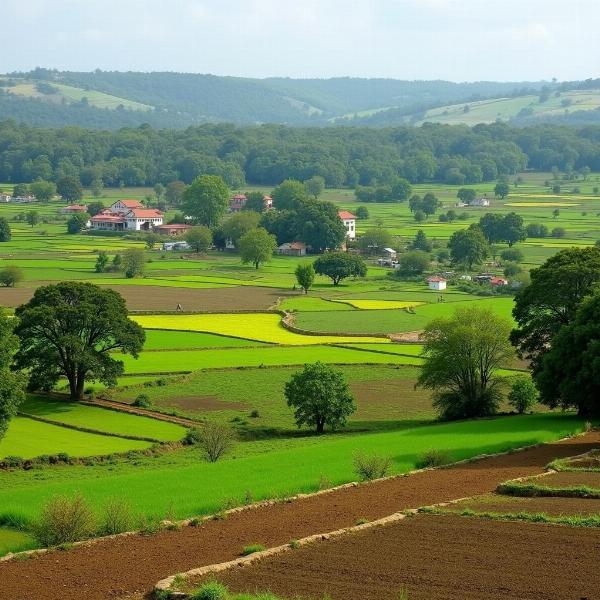Inamgaon, a name that echoes through the annals of Indian history, often sparks curiosity. What does “inamgaon” meaning in hindi truly signify? This article delves into the rich historical, cultural, and linguistic nuances associated with this term, providing a comprehensive understanding of its significance in the Indian context. We’ll explore the origins, the societal implications, and the relevance of Inamgaon in contemporary India.
Unraveling the Meaning of Inamgaon
The term “inamgaon” (इनामगांव) is a compound word in Hindi. “Inam” (इनाम) translates to “gift” or “reward,” while “gaon” (गांव) means “village.” Therefore, “inamgaon” literally translates to “gifted village” or “reward village.” Historically, these villages were granted as rewards, often to individuals for meritorious service or loyalty to the ruling power. This practice was prevalent during various periods in Indian history, particularly under the Maratha and British rule.
 Inamgaon Village Landscape
Inamgaon Village Landscape
The Historical Significance of Inamgaon
Inamgaons played a significant role in the socio-economic fabric of historical India. The grant of an inamgaon often conferred certain privileges upon the recipient, including revenue collection rights and administrative control. This system, while seemingly beneficial, also contributed to the creation of a hierarchical social structure, with the inamdar (the holder of the inam) wielding considerable power.
Inamgaon and the Maratha Empire
Under the Maratha Empire, the practice of granting inamgaons flourished. It served as a crucial tool for the rulers to reward loyal soldiers, administrators, and even religious figures. This system played a vital role in consolidating the Maratha power and expanding their influence across the Indian subcontinent.
Inamgaon under British Rule
The British, after consolidating their power in India, continued the practice of granting inamgaons, although with modifications. They often used it as a means to secure the loyalty of local chiefs and influential figures. However, the British administration also introduced reforms aimed at regulating the inam system and addressing some of its inherent inequalities.
Inamgaon in Contemporary India
While the system of granting inamgaons is largely a relic of the past, the term continues to hold cultural and historical significance. Many villages across India still bear the name “Inamgaon,” serving as a reminder of their historical status. Furthermore, the term often features in historical accounts, literature, and popular culture, reflecting its enduring presence in the Indian collective consciousness.
Legal and Administrative Aspects
The legal status of inamgaons and the rights of inamdars have been subjects of various legal and administrative processes in post-independence India. Several states have undertaken land reforms aimed at abolishing the remnants of the inam system and redistributing land to landless farmers.
Conclusion: Inamgaon – A Legacy of History and Culture
“Inamgaon meaning in hindi” encapsulates more than just a simple translation. It offers a glimpse into a complex historical system that shaped the socio-economic landscape of India. Understanding the meaning and significance of this term provides a deeper appreciation of Indian history, culture, and the evolution of its rural communities. While the system itself may be a thing of the past, the term “inamgaon” continues to resonate, reminding us of the intricate tapestry of India’s rich heritage.
FAQ
- What does “inam” mean in Hindi? “Inam” means “gift” or “reward.”
- What is the historical significance of inamgaons? Inamgaons were granted as rewards for service or loyalty, influencing the socio-economic structure of historical India.
- Did the British continue the inamgaon system? Yes, with modifications, using it to maintain control and secure local alliances.
- Do inamgaons still exist in modern India? The system of granting inamgaons no longer exists, but many villages retain the name.
- What are the legal implications of inamgaons today? Land reforms have addressed the remnants of the system, aiming for equitable land distribution.
- Where can I find more information on the history of inamgaons? Historical archives, academic texts, and local libraries can provide more detailed information.
- How did the inamgaon system affect social hierarchy? It created a hierarchical structure, with inamdars holding significant power.
Connecting with Meaning-Hindi.in
Meaning-Hindi.in offers expert translation services between Hindi and various other languages, specializing in business, legal, technical, website localization, educational, and specialized translations. Our expertise in historical and cultural contexts ensures accurate and nuanced translations for diverse needs. For professional and reliable translation services, contact us at [email protected] or call +91 11-4502-7584. Meaning-Hindi.in is your trusted partner for all your translation requirements.